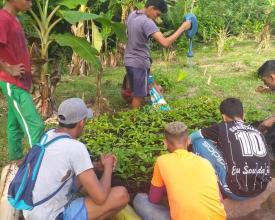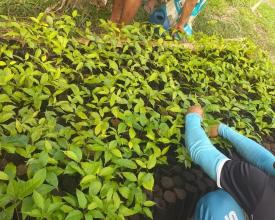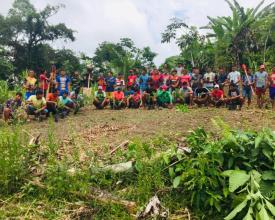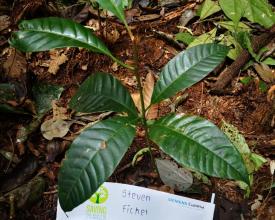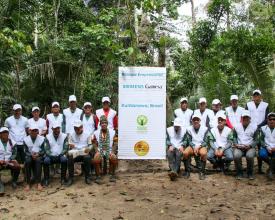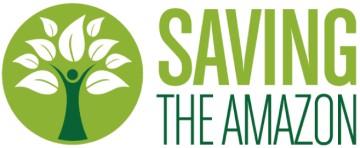
Saving the Amazon

Knowing that a solution to reverse the main problem of humanity, the climate crisis, is in the Amazon, our work is to unite people and organizations around the world to support indigenous communities in this work. To do this, we developed a sustainable, replicable and scalable model that consists of the following: 1) People adopt a tree 2) The indigenous people plant it 3) They mark it with the person's name 4) They take a photo of the tree which is uploaded to our SAVING GEAR platform. 5) The person receives an email with the photo along with a certificate containing all the information of the planting. 6) During the next 3 years, the indigenous communities take photos of the tree and upload it to the platform every six months. We are currently developing plantings in Colombia and Brazil.
Context
Challenges addressed
The Amazon is one of the main ecological altars and of major relevance for the climate stability of the planet for containing 6.7 million km2 of forest, 10% of the carbon stock, + 350 indigenous communities, 20% of fresh water, 20% of the fauna and is contained in 8 countries in Latin America. Unfortunately, it has been deforested by 17%, if this percentage reaches 20%, the consequences would be irreversible. On the other hand, the indigenous populations that inhabit it concentrate a level of multidimensional poverty between 70% - 98%. Taking this information, Saving the Amazon's CHALLENGE is to ensure that these populations continue to protect the environment, generating an impact on the climate crisis and reducing their poverty levels, and all that this represents, and all this through dignified work that is aligned with their knowledge, experience and ancestry.
Location
Process
Summary of the process
Today most companies in the world measure their impact in terms of the SDGs. Having created measurement methodologies based on these goals has helped us to link a greater number of companies to our project, which translates into a greater environmental and social impact because with just one partner we have the possibility of planting many trees and providing work for many indigenous families.
Building Blocks
Business Alliances
One of the lines we have is the creation of corporate forests. What we do is to link companies to implement their corporate social responsibility strategy through us by planting a forest in the Amazon. Many companies implement it to integrate their different stakeholders (employees, customers, partners, suppliers, etc.) in their strategy, planting a tree on behalf of each of them, which has proven to be very successful.
Enabling factors
- Have sufficient physical and human infrastructure capacity to implement the projects.
- To have the technological tools to be able to monitor and control.
- To have the administrative capacity to meet their requirements.
Lesson learned
- The areas of the organization must be flexible to adapt to different types of demand.
- Identify in time which variables are sensitive to changes in order to react quickly.
Impact Measurement
We are constantly working to measure our environmental and social impact in terms of the internationally known Sustainable Development Goals. This has allowed us to find synergies between our project and other organizations which in turn has accelerated our growth.
Enabling factors
1. Be very clear about each of the Sustainable Development Goals (Targets/Goals).
2. Have a baseline for comparison.
3. To have measurement methodologies.
Lesson learned
1. It is important to plan the measurement methodologies very well so that the results are as expected.
2. Periodicity must be established for the application of measurement methodologies.
Resources
Impacts
During 2020, we grew by 375% in tree planting, which translates into a proportional increase in the income of indigenous families.
We have achieved the involvement of large companies in the world that support our actions such as: Siemens Gamesa, Amadeus, Banco de Bogotá, Dell, Unilever, Johnson & Johnson, PayPal, Sacyr, Google, among others.
In 2020, we began to develop surveys to our beneficiaries measuring our impact based on the goals and KPIs of the SDGs. Today we have statistics such as the following: 1) The only income that 75% of the families that are part of our project have, is the one that comes from Saving the Amazon, 2) Saving the Amazon involves women in their activities.
We have developed other sustainable projects for the indigenous communities for which they receive income such as an ethnotourism experience and the commercialization of handicrafts.
We have developed our technological solution to provide quantitative information on community specificities, planter information and spatial data for each donation, thus improving the user experience.
We started paying the communities for their services not only with cash but with the implements they need (appliances, salt, hooks, etc.).
Beneficiaries
At the moment, the indigenous communities living in the Colombian and Brazilian Amazon, specifically we work with 18 communities and 262 indigenous families.
Sustainable Development Goals
Story

We started Saving the Amazon as a result of a crazy ambition to reverse climate change and help vulnerable people. We started in a small village in the middle of the Colombian Amazon jungle called Tayazu (Department of Vaupés/Colombia), with a few indigenous families and planting few trees. After many years of effort and dedication, we have achieved the involvement and commitment of 18 indigenous communities and more than 262 families and planted thousands of trees. Currently we have managed to position ourselves at a national level (Colombia), among people, companies and institutions. We are also beginning to position ourselves in Latin America and Spain, the first has been organic and in Spain, in 2020 we hired a country manager to open this new market with very positive results. In 2020, with individual sales representing 6% of our revenues, we grew 175%. On the other hand, with corporate sales representing 94% of our revenues, we grew by 475%.
